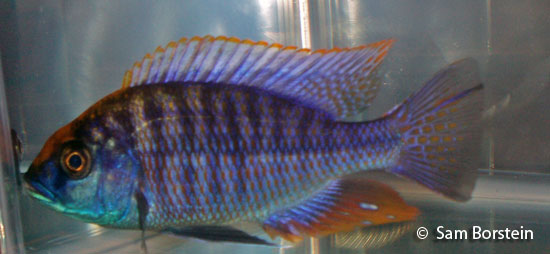Protomelas spilonotus
(Trewavas, 1935)
Sulfur Head Haplochromis
Synonyms: Haplochromis ovatus, Haplochromis spilonotus

Above: A male Protomelas spilonotus. Photo by Sam Borstein.
Etymology:
Genus- Proto= first (Greek), melas= black (Greek).
Species-spilo= dot (Greek), notus= back (Greek).
Intro:
Protomelas spilonotus is a beautiful Lake Malawi mouth brooder. This species, which gets quite large for a Malawian is shocking in color and for its size, very shy. This fish is often confused with Protomelas sp. "spilonotus tanzania", which is known as the blue & yellow hap and occasionally called Protomelas insignis. These species are very different in appearance, but close in relation.
Distribution:
This fish is found at Mara Rocks, Chilumba, Ruarwe, Eccles Reef, & Mbenji Is., Malawi; Nkhungu Reef, Nkhungu Pt. in Lake Malawi. The Mara Rocks locality is the best known. This fish lives in very shallow, rocky habitats, unique for Protomelas species.
Size, Maturity, and Sexual Dimorphism:
Size: Males- 12 inches, Females- 9 inches
Maturity: 6 inches
Sexual Dimorphism: Males are larger than females and are more colorful than the females which are gray.
Care:
Protomelas spilonotus is not hard to care for. This fish is peaceful for its size. They do need swimming room, so a large tank is required. This fish, due to its size is also messy, so weekly water changes are needed.
Diet:
Protomelas spilonotus is carnivorous and feeds on insects and invertebrates in the wild. In aquaria it will gladly take most prepared foods in aquaria.
Breeding:
These fish are relatively easy to breed. Females do take quite a while to become gravid, but when they are, will readily breed. Males can be rough on females during this time, but not much damage is usually done.
Females hold relatively well and have spawns of 24-40 eggs, which are good size. Fry are easy to rear and grow pretty quick.

Above: A male Protomelas spilonotus in breeding color. Photo by Rick Borstein.
Conclusion:
This beautiful fish is great, especially if you can find them. They are large, but worth the amount of space they take up. They are a project as they are slow growing and take a while to reach maturity.
References:
- Konings, A. (2007) Malawi cichlids in their natural habitat. 4th ed., Cichlid Press, El Paso, Texas, 424 pp.
- Trewavas, E. (1935) A synopsis of the cichlid fishes of Lake Nyasa. Annals and Magazine of Natural History, 10, 65–118.
